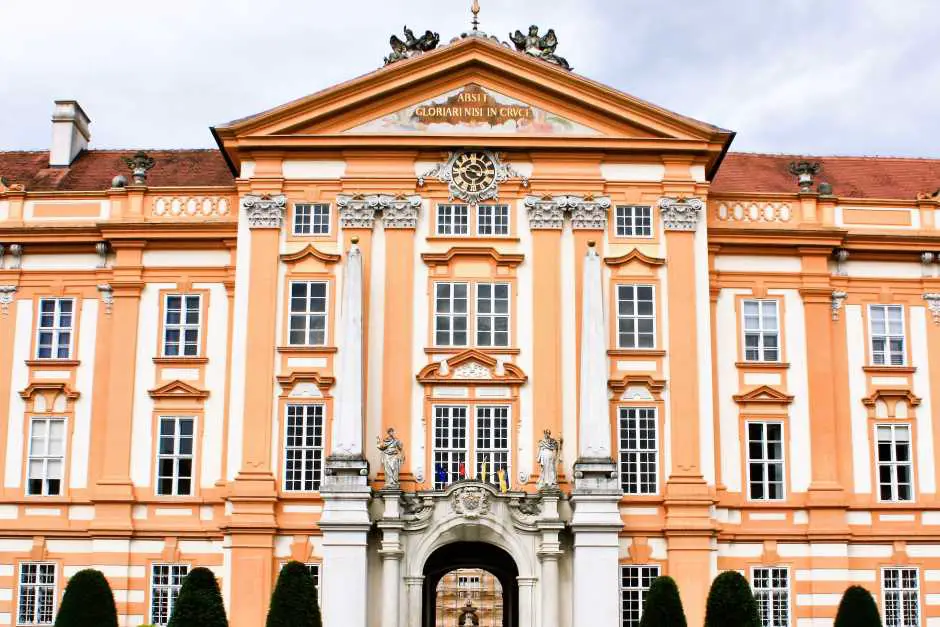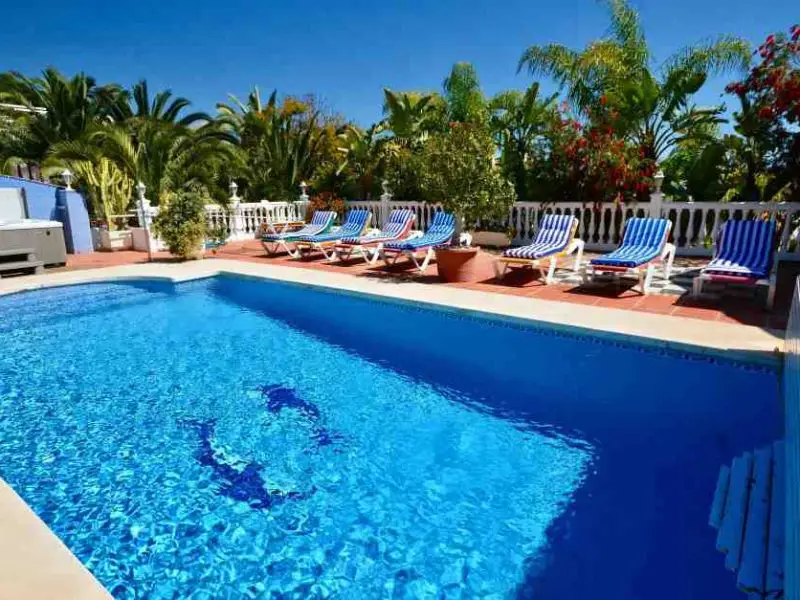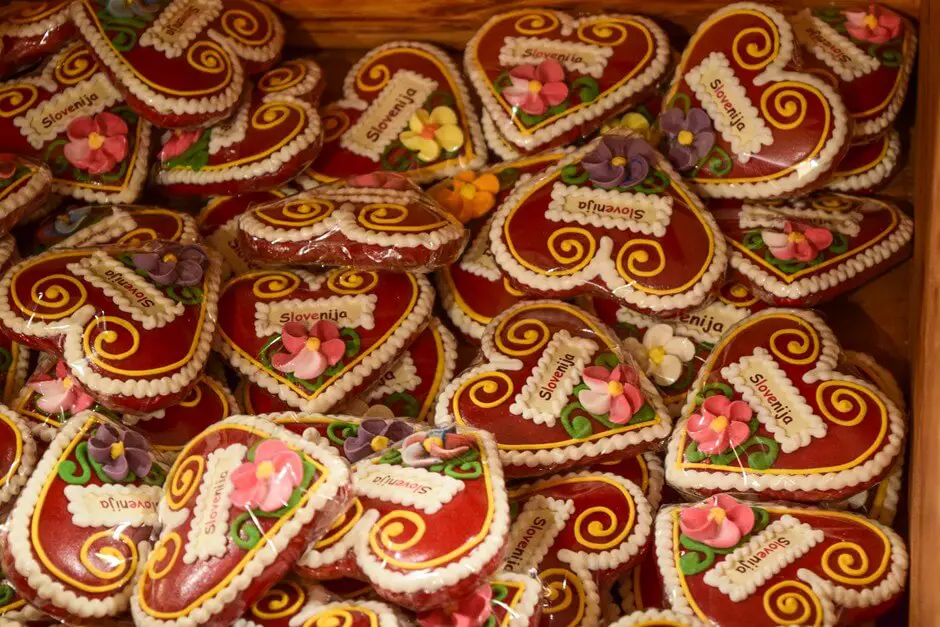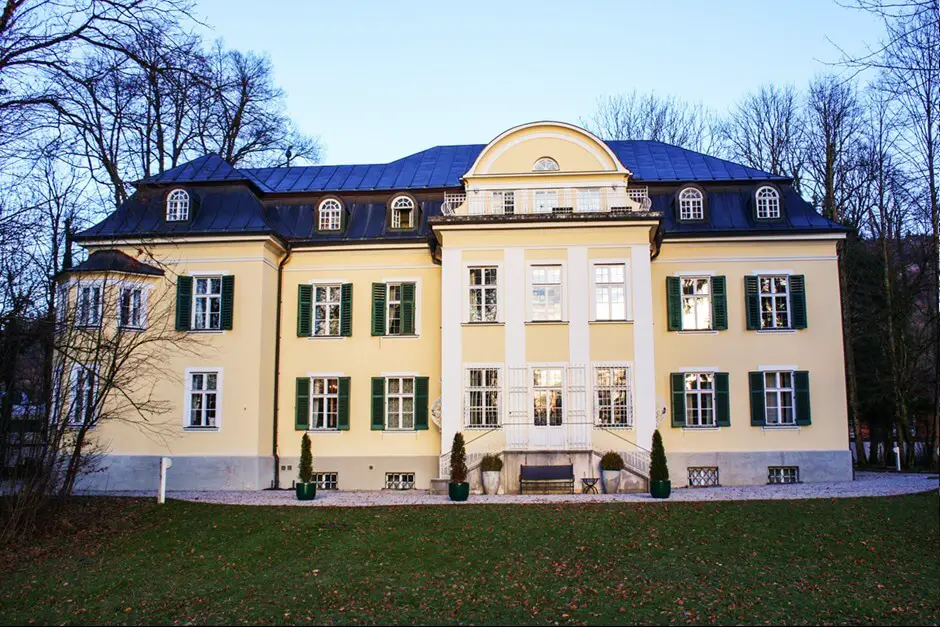Melk Abbey in Austria
(Advertising) It is one of the highlights on the Danube in the Wachau: Melk Abbey in Austria. It is now a UNESCO World Heritage Site in Austria. If you approach Melk Abbey from the Danube or from the north via the motorway, it towers like a fortress above the town that bears the monastery's name. We have been to Melk Abbey several times on press trips and can never get enough of the baroque splendour of the monastery. That is why we are always drawn there - whether as a travel bloggers or on private visits.
Silence in this Austrian monastery on the Danube
I remember our last visit to this Austrian monastery on the DanubeWe explored the magnificent halls and strolled through the quiet gardens. The atmosphere was incredibly peaceful. The library with its ancient books is particularly impressive. After the tour, we enjoyed a good lunch in the monastery café. The silence of the place remains unforgettable. It was a wonderful day full of discoveries and peace.
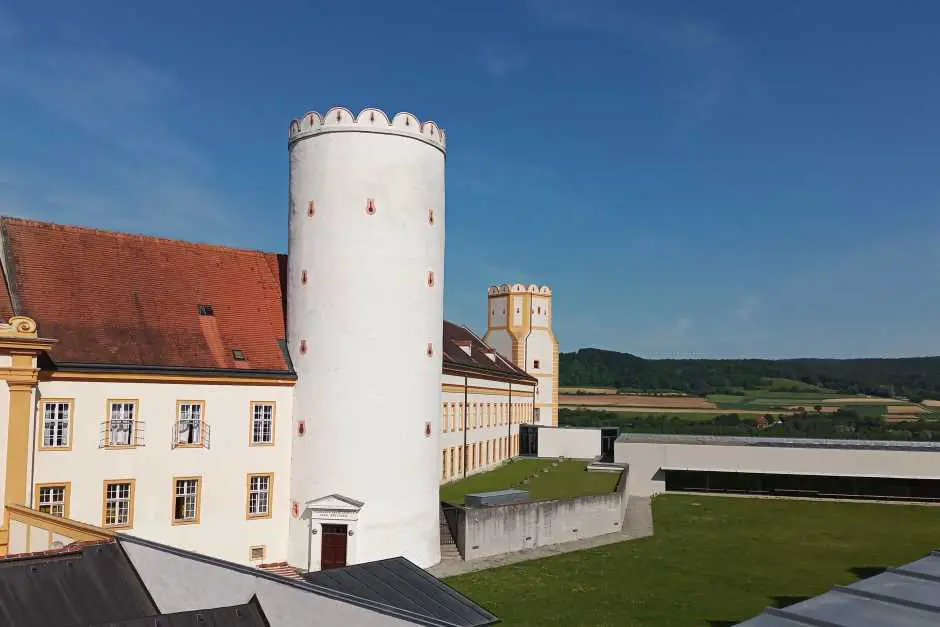
Melk Abbey grew out of a castle
You are not wrong with this assumption. Because originally there was actually a castle on the site of the Benedictine monastery. In 955, Otto the Great handed over the Ostland to Luitpold from Babenberg. The Ostmark came into being, which was first referred to in the chronicles as Ostarrichi in 996. Melk Castle initially belonged to Bavarian counts. However, the Babenbergs soon took over the castle. Art objects from this dynasty can still be found in the monastery's possession today.
Book your accommodation in Melk here*
If you book one of these offers, we receive a commission, which we use to run this blog.
It was also the Babenbergs who helped Melk Abbey to get its own saint. In 1014 Henry Ist brought the body of St. Koloman to Melk. According to legend, he was a king's son from Ireland. He had been arrested in Stockerau as a spy and was hanged on an elder tree.
Not much remains of the Babenberg castle. Only the two castle towers are still standing and tower over the Danube as they have for ages.
Do you want to actively experience the Wachau? Here are tips.
If you book one of these offers, we receive a commission, which we use to run this blog.
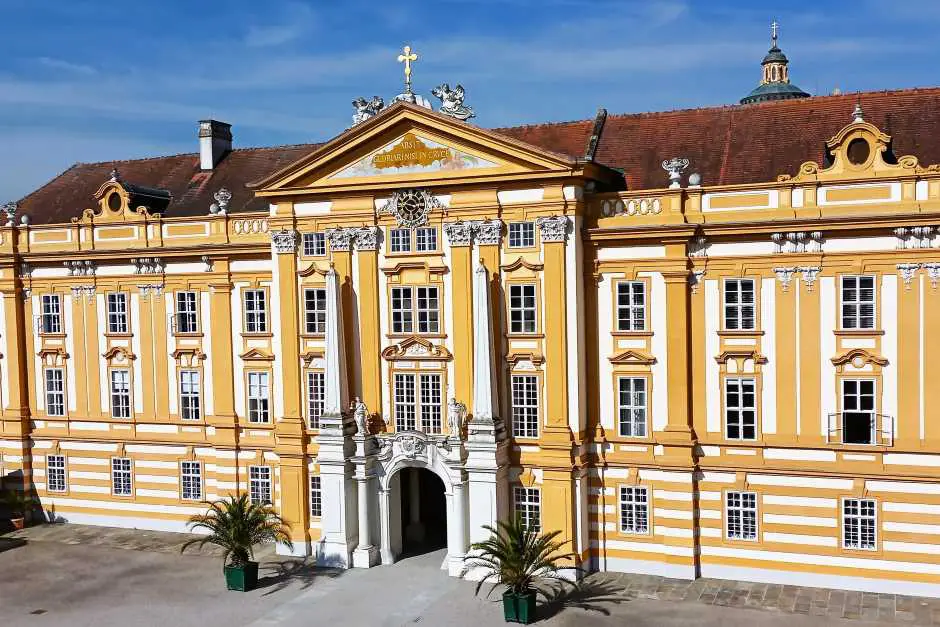
Baroque splendor in Melk Abbey
The Babenberg period was followed by economic decline and a decline in morals in the Melk monastery. A fire destroyed almost the entire monastery. The plague, crop failures and other plagues did the rest. The Melk reform in the 15th century led to a brief recovery. However, the Reformation and the Turkish wars in the 16th century destroyed these. It was only during the Counter-Reformation that the monastery was able to build up an economic base that made it possible to rebuild the monastery in the Baroque style. Melk Abbey experienced its heyday with the conversion of the monastery in the Baroque style according to plans by Jakob Prandtauer. It took only 40 years to convert the monastery to its baroque splendor. Even another fire could not stop the completion.
Interactive map for this monastery on the Danube in Austria
Large baroque monastery in Lower Austria
Melk Abbey is undoubtedly one of the largest baroque monasteries in Lower Austria. The architecture of the monastery is a real feast for the eyes, which inspires every visitor. The monastery is located on a rock that towers majestically over the Danube. The facade of the monastery is a masterpiece of baroque art and architecture. Richly decorated with statues and ornaments, the monastery is a sight that takes your breath away. Inside the monastery is a library that is considered one of the finest in the world. The impressive shelves and artistic murals make every book lover's heart beat faster. The magnificent collegiate church, decorated with marble and gold, is also an unforgettable experience for every visitor.
The Age of Enlightenment caused a reorientation in Melk Abbey. A high school moved in. No local abbot could be elected. Instead, a commander-abbot moved in. The emperor appointed a prior who was responsible for the monastic economy. After the Napoleonic Wars, the modernization of the monastery finally began. The baroque buildings have been restored. Actually, the renewal of the buildings is a permanent process. Girls were allowed to attend classes in high school. A student exchange with a Benedictine school in America began. Tourism contributes a lot to the financing of these measures.
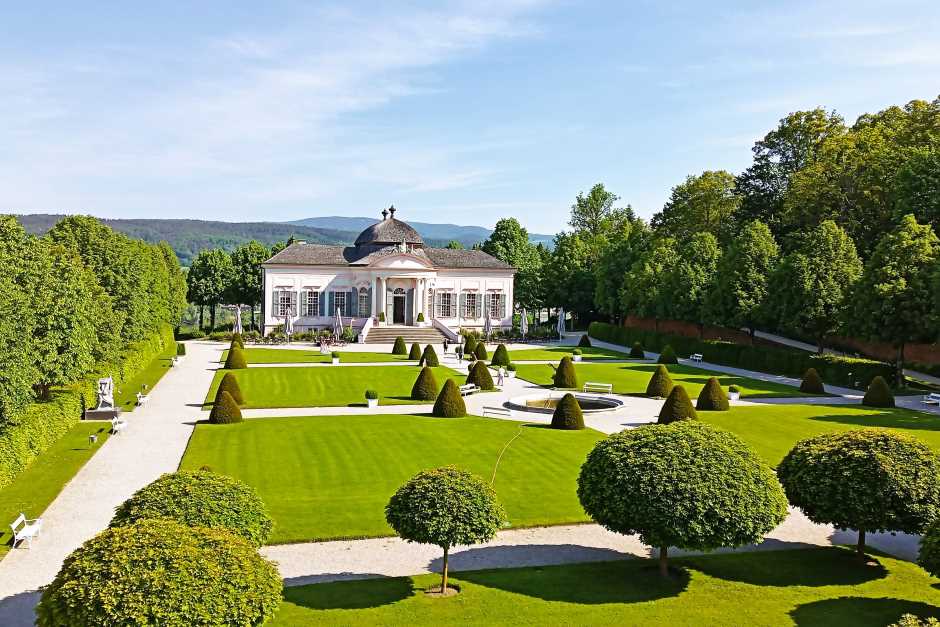
Visit to Melk Abbey
View from the roof of the North Bastion
The best place to start a tour of Melk Abbey is from the roof of the north bastion. You can reach this via the lift from the monastery shop. From above you have a good view of the former Melk Castle, the baroque main building and the monastery park with its garden pavilion.
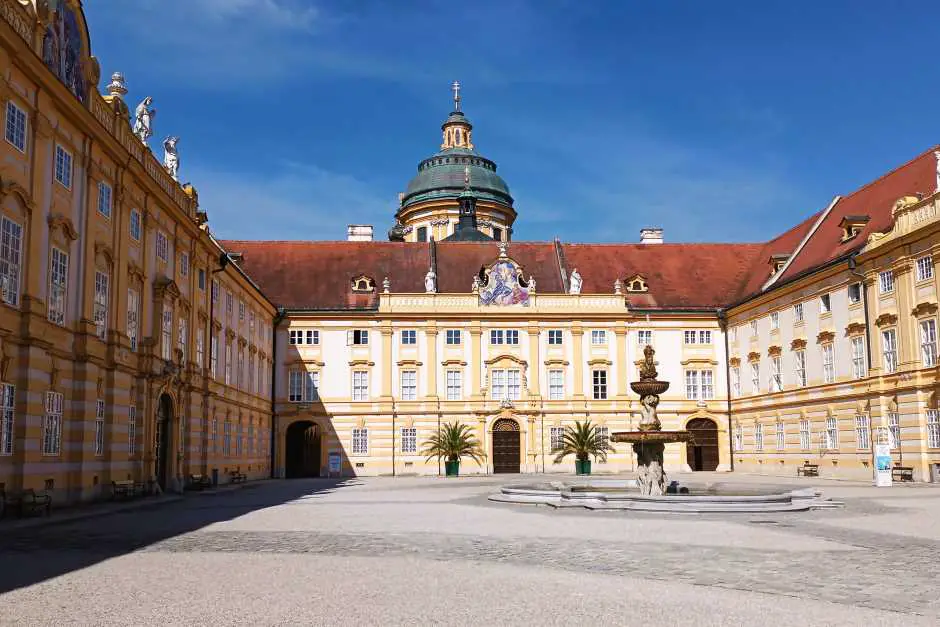
The Prelates' Court
Through the main portal (see third photo from above) you finally reach the prelate's court. This is located in the center of the monastery complex. The high school is located in the building today.
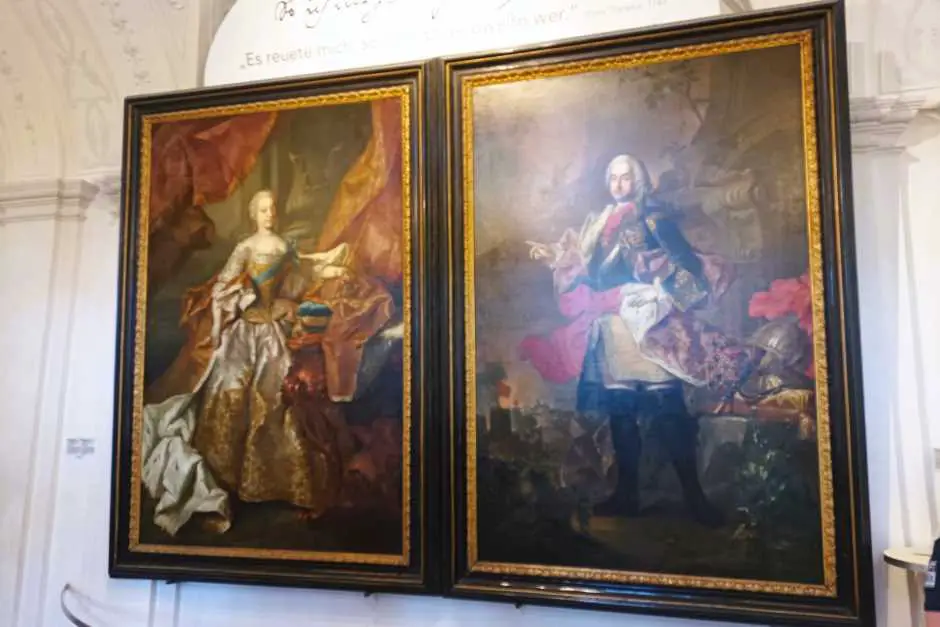
The Kaiserstiege and the Kaisergang
Empress Maria Theresa and Emperor Franz Stephan of Lorraine were guests at Melk Abbey several times. Their portraits hang at the foot of the Kaiserstiege in the Kaisergang. If you then follow the Kaisergang, you can see paintings of other rulers from Austria from the Babenbergs to the Habsburgs.
The Kaiserstiege leads up to the Kaiserzimmer on the first floor. It now houses the Museum of Melk Abbey.
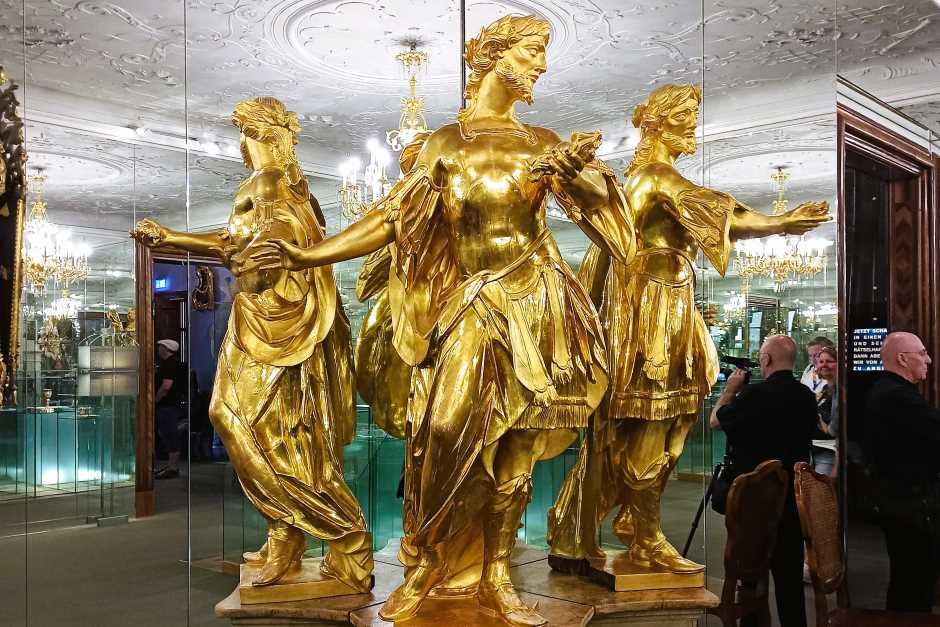
Kaiserzimmer (Monastery Museum of Melk Abbey)
The monastery museum is located in the rooms where the emperor and his family once stayed when they visited Melk Abbey. This shows how important Melk Abbey was in history. There you can see the art treasures of the monastery. You will also learn more about the current role of the abbey.
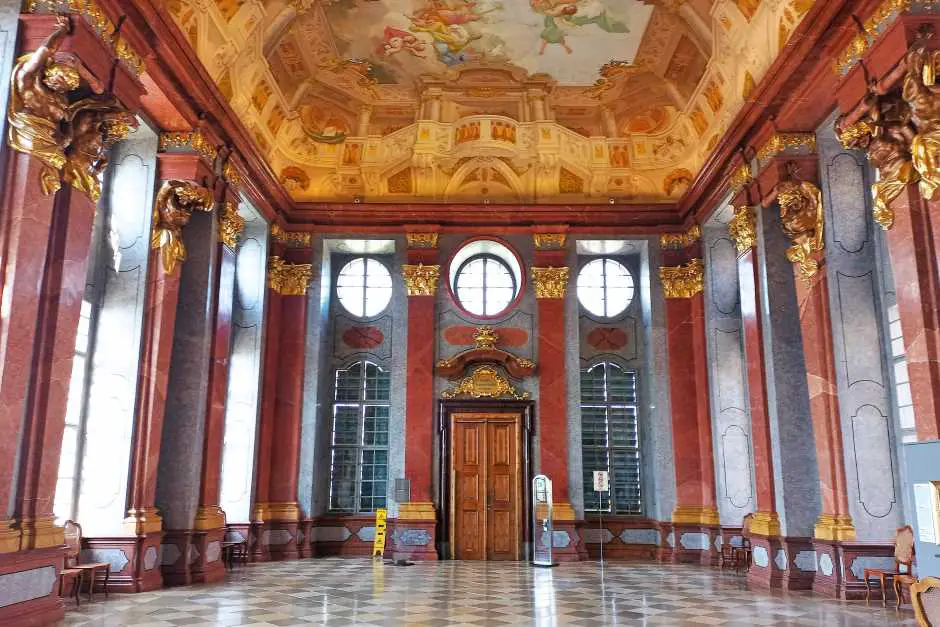
The Marble Hall
The Marble Hall, which follows the museum, is also worth seeing. This hall serves as a festival and dining room. Although it is called the Marble Hall, only the door frames and the attachments above the doors are made of real marble. The walls, on the other hand, are painted by Gaetano Fanti. The ceiling painting by Paul Troger is also worth a look.
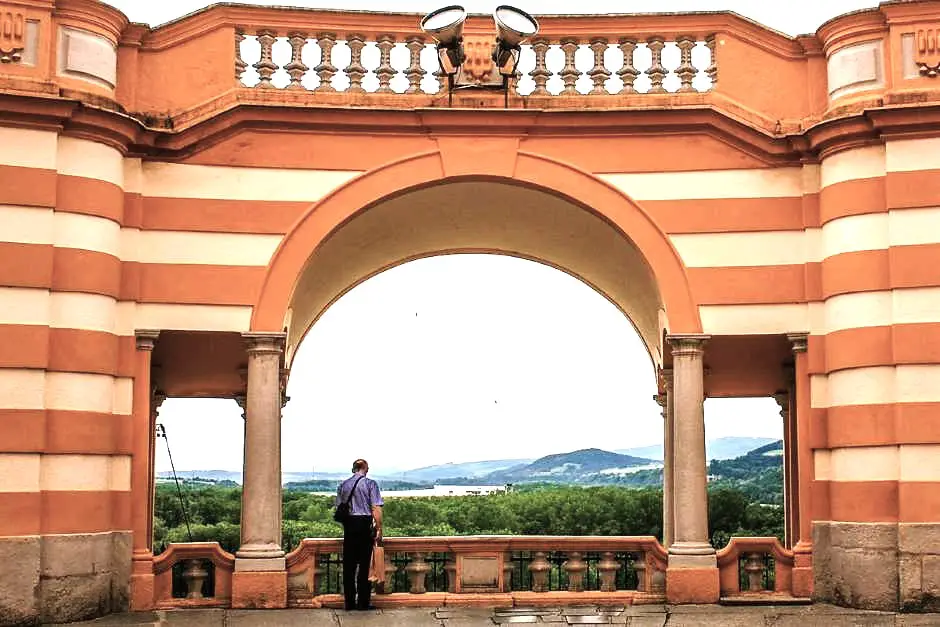
The terrace with a view of the Danube
Leaving the Marble Hall, one then arrives at the balcony, a terrace that leads over to the library. From here you definitely have a magnificent view of the Danube.
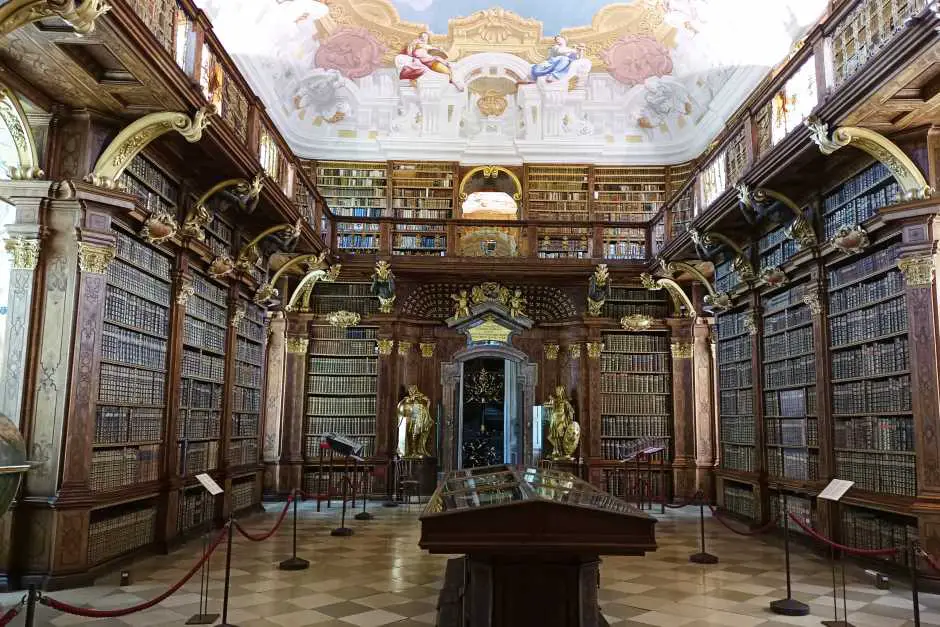
The abbey library of Melk Abbey
As soon as I enter the Abbey Library of Melk Abbey, I hold my breath. Under the ceiling fresco by Paul Troger are the bookcases with their marquetry work. The figures next to the doors represent the four faculties: jurisprudence, medicine, philosophy, and theology. The abbey library has around 100.000 volumes, 1.200 manuscripts from the 9th to 15th centuries, 600 manuscripts from the 17th and 18th centuries and 750 incunabula. Interesting manuscripts from the library fund are also displayed in the showcases.
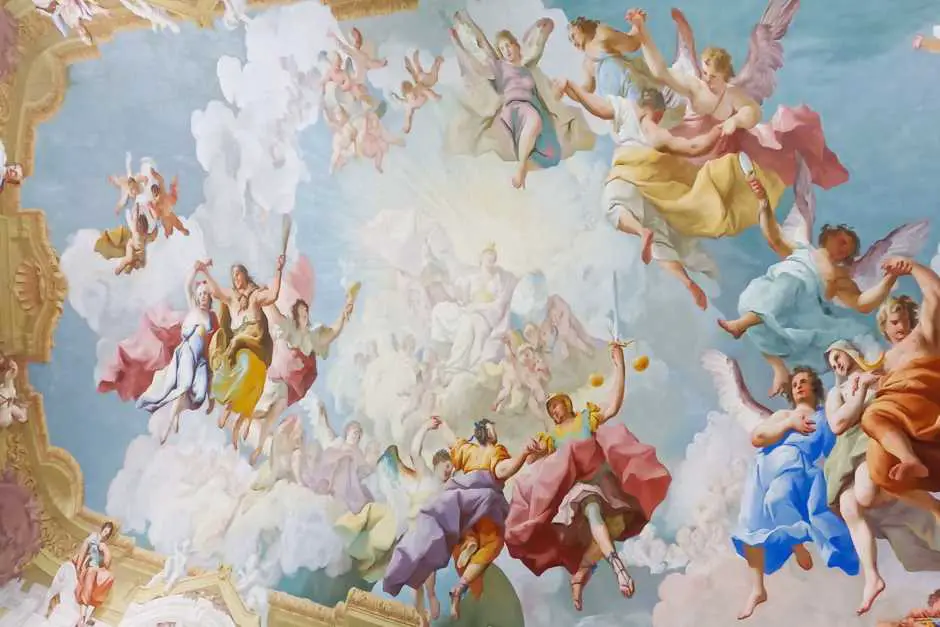
The restoration of the Melk library's holdings began in 2022. Plans include a new manuscript chamber and an extension of the library premises. Librarians and restorers will examine and clean the book holdings from centuries. A Sisyphean task that is scheduled to take 10 years. The cost of the project is 12 million euros. The project is financed through sponsorship from companies, book sponsorships, the sale of facsimiles and merchandise products, among other things. Anyone who would like to provide support can contact the Ex Litteris Immortalitas Friends Association for further information. E-mail: exlitteris@stiftmelk.at.
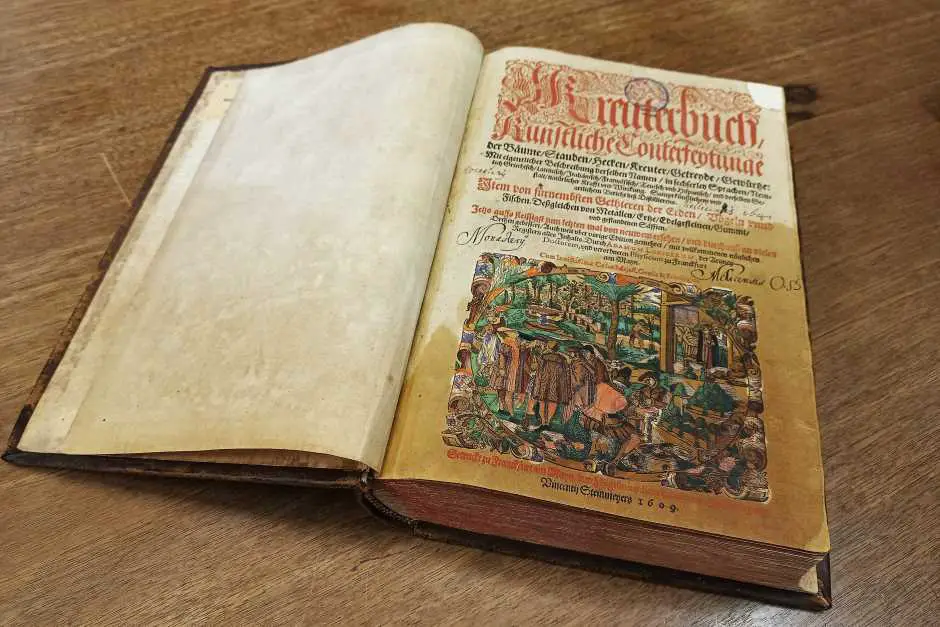
The guided tour through Melk Abbey, which every visitor can take, ends here. However, as part of our press trip, we are allowed to look behind the scenes of the library. Bernadette Kalteis and Johannes Deibl are working on this project. They show us books that are being restored. This includes, for example, this herbal book from the year 1609.
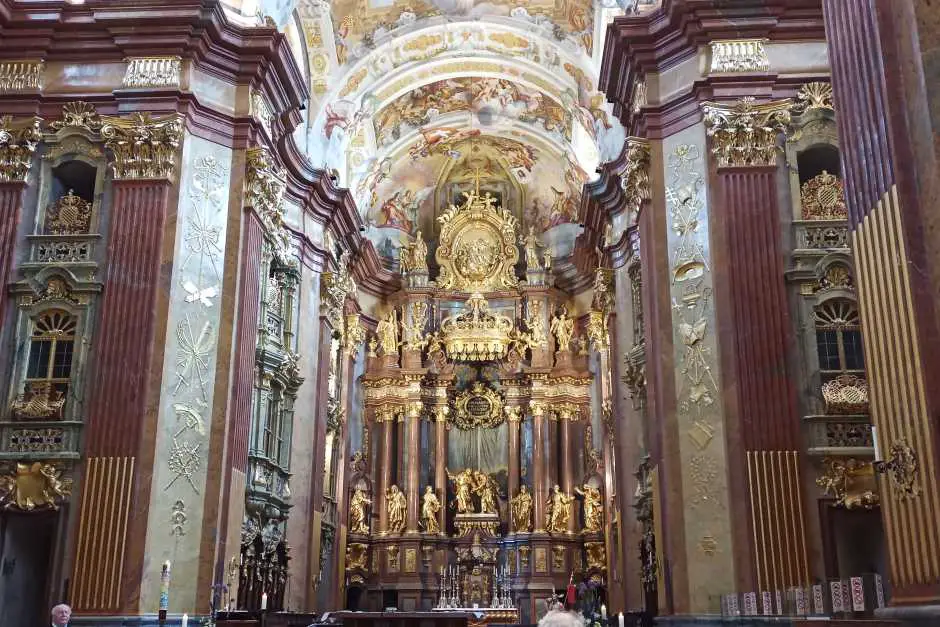
The collegiate church in Melk
A visit to Melk Abbey is not complete without a visit to the collegiate church. It is best to do this at 12.00 p.m. for the noon prayers of the monks. This lasts half an hour and allows an insight into the everyday life of the monks. At the same time, there is the opportunity to review the previous impressions from Melk Abbey, Austria, in front of your inner eye. During our visit, a guitar player accompanied the monks' choral singing. We really enjoyed that, as did the young guests from all over the world.
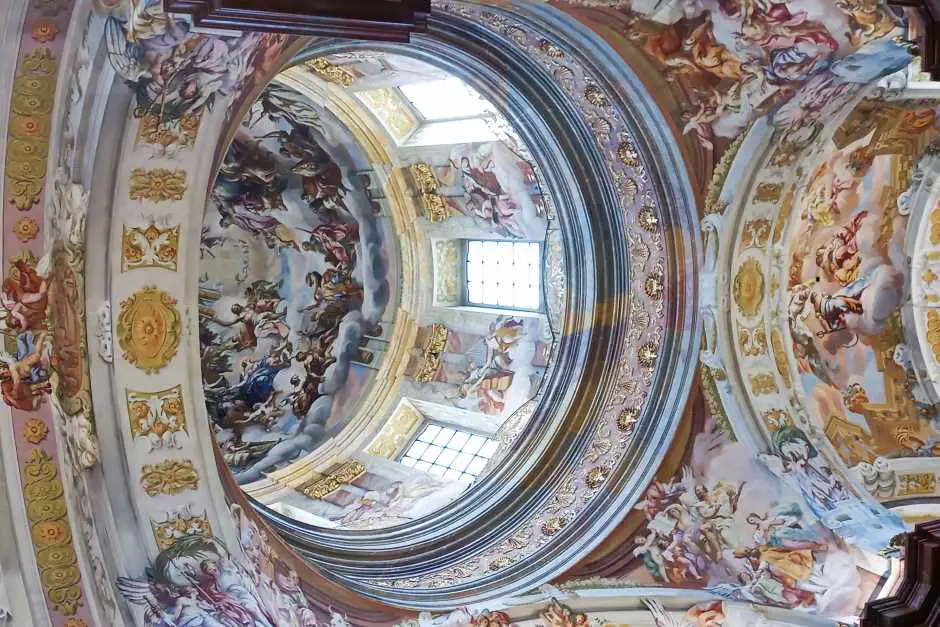
The ceiling painting by the Tyrolean artist Johann Michael Rottmayr is also magnificent to look at. The Italian theater engineer Antonio Beduzzi designed the side altars like chapels.
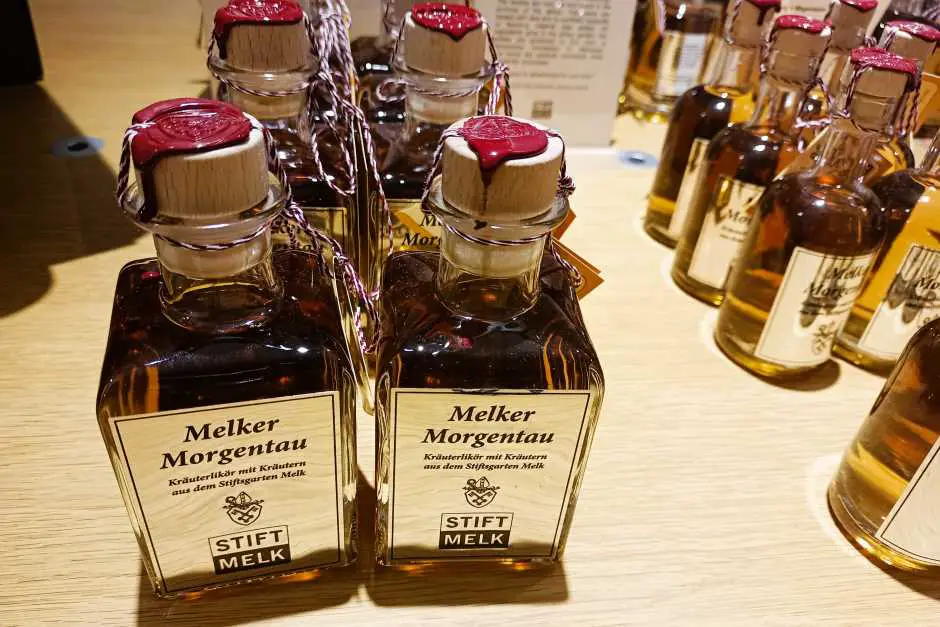
Shopping in the monastery shop
Before we enjoy our lunch in the monastery gastronomy, we make a detour to the monastery shop. In addition to postcards showing the monastery, you can also buy products from the monastery and the monastery garden there. We are particularly fond of the herbs and medicinal plants that are processed into liqueurs, herbal salts, chocolate and other products.
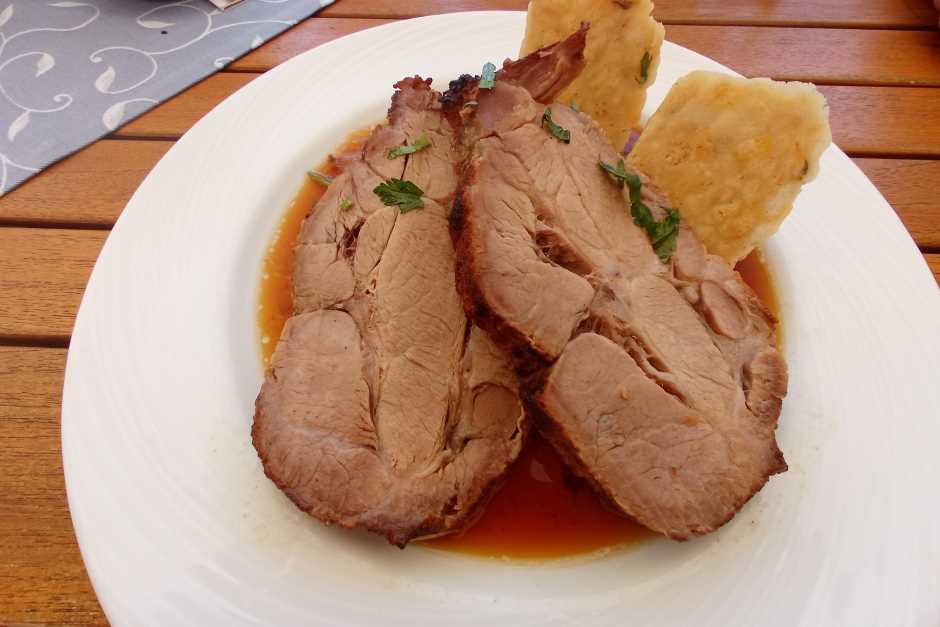
Lunch in the restaurant at Melk Abbey
After enjoying the art, we want to savor the culinary treats. With a bit of luck, we finally get a table on the terrace. However, it is better to reserve a table. The restaurant in Melk Abbey is very popular. We order a roast pork with dumplings. We were served a huge portion, which is guaranteed to satisfy even the biggest hunger.
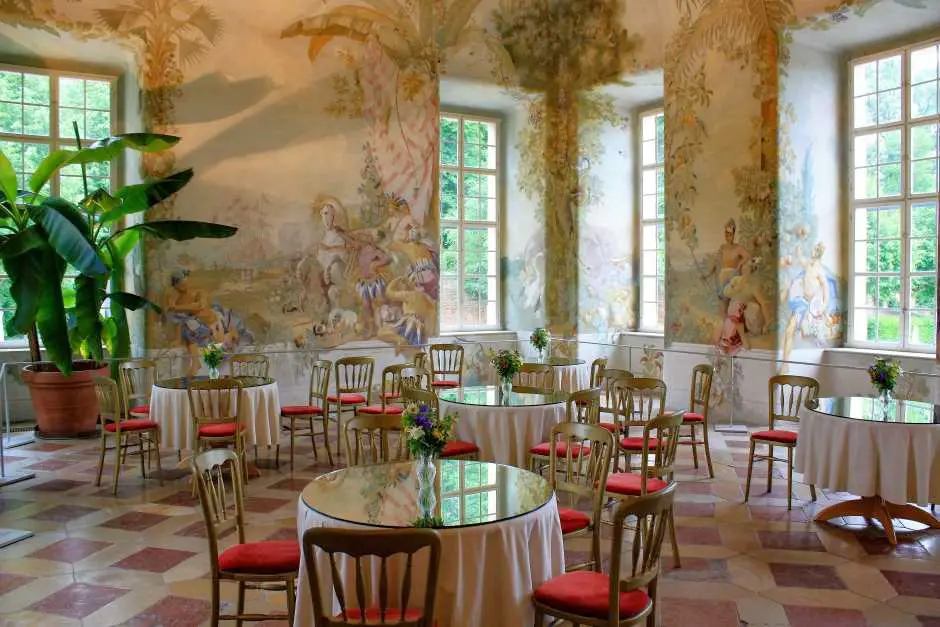
The abbey park and the garden pavilion
At the end of our visit to Melk Abbey, we take some time for a walk through the abbey park. You can also take a 70-minute tour of the park. We did the tour on our trip through three monastery gardens in Lower Austria. This time, however, we don't have that much time. However, we do not want to miss a visit to the garden pavilion. The exotic frescoes by Johann Wenzel Bergl are always worth a visit. If you feel like it and have the time, you can also enjoy coffee and cake there.
Parking
You can also park for free with your entry ticket. You then have to validate the parking ticket when you buy the ticket.
Opening hours, prices and guided tours in Melk Abbey 2025
You need this to visit Melk Abbey
- Wear comfortable shoes for wide feetwhere you can walk well even on rough paths
- A backpack is definitely practical for everything you need on the go.
- The region also offers beautiful photo opportunities. Therefore, you should bring a camera .
Have you already been to Melk Abbey?
How were your impressions? Did you experience anything special there? Maybe you also have tips that can help other visitors? We look forward to your tips in a comment. Our readers will also greatly appreciate these.
Do you like to travel by motorhome?
– Do you want to rent a mobile home? Then you can find information here, for example, as well as booking options. Or would you rather stay overnight in a roof tent on the car? In addition, the overnight stay in camping tents is possible.
— Be sure to check our
packing list for campers whether you have packed everything for your motorhome tour. Then you are ready for your weekend in the Wachau.
— You want to know where you can stay with a motorhome
in Europe and are looking for campsites? You can find information on this, for example, under this link.
— A Melk campsite, Kolomaniau 3, 3390 Melk, Austria.
There are other campsites nearby*. After a day trip you can prepare your meal in a Dutch Oven or on the portable grill. You can also find Dutch oven accessories here.
— Why is a folding e-bike useful when camping?
If you book via a link marked *, we receive a commission, which we use to run this blog.
You need this for a hike at Melk Abbey in the Wachau
- Pack your backpack with our packing list for hikers. Then you are guaranteed to have everything you need on the go.
- Wear comfortable walking shoes for wide feetwhere you can walk well even on rough paths
- A large backpack is definitely practical for everything you need on the go.
- The region also offers beautiful photo opportunities. Therefore, you should bring a camera .
- Are you looking for other equipment for hikers?
- You can find hiking stages on the World Heritage Trail through the Wachau here
Learn more:
- Official Website
- Wikipedia
- UNESCO Wachau
- Visit Melk
- monastery archive
- Abbey library
- Article about the Melk Reform in the 15th century
Travel Arrangements:
Parking at the airport
Here you can reserve your parking space at the airport.
Arrival by plane, public transport or car to Melk Abbey, Austria
Compare and book flights here*. (Advertisement) The nearest airport is Vienna Schwechat. From there you can travel to Melk either by rental car or by public transport. There is also a train station in Melk.
Car Rentals:
Cheap rental cars – book here!
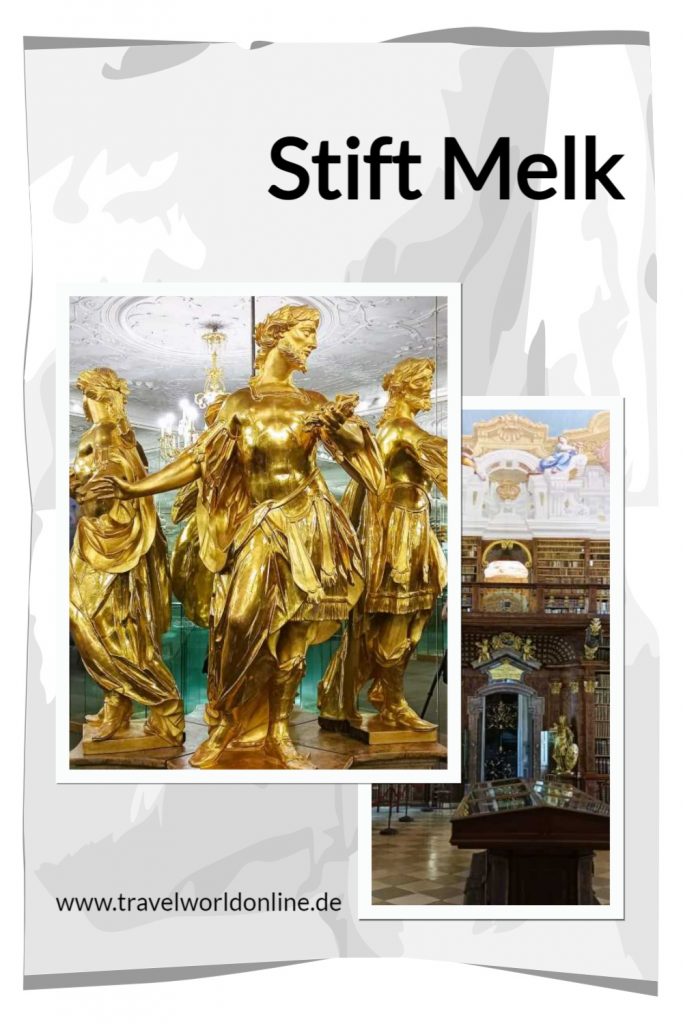
Do you know this?
- Discover the Wachau Austria for connoisseurs
- Experience the Wachau: A boat trip full of breathtaking views
- Göttweig Abbey in the Wachau in Austria
- Durnstein in the Wachau
- This is what a monastery holiday in the Benedictine Abbey of St. Paul in Lavanttal is like
- Lilienfeld Abbey Hiking - Muckenkogel & Klosteralm
- Cheese and cheese production in the Waldviertel
- Krems at the Donau
- Experience the Wachau in autumn
- Wachau Hotels on the Danube for your wine journey through the Wachau
- A Day in Ottawa: Ontario Canada in Spring
Source Melk Monastery: research on site. Sources for History of the monastery: Melk Abbey. We would like to thank Klösterreich and Melk Abbey for the invitation to this trip. However, our opinion is our own.
Updated on 24.11.2024
Text Stift Melk Austria: Monika Fuchs and TravelWorldOnline
Photos Melk Abbey Austria: Monika Fuchs and TravelWorldOnline
Video: Petar Fuchs and TravelWorldOnline
